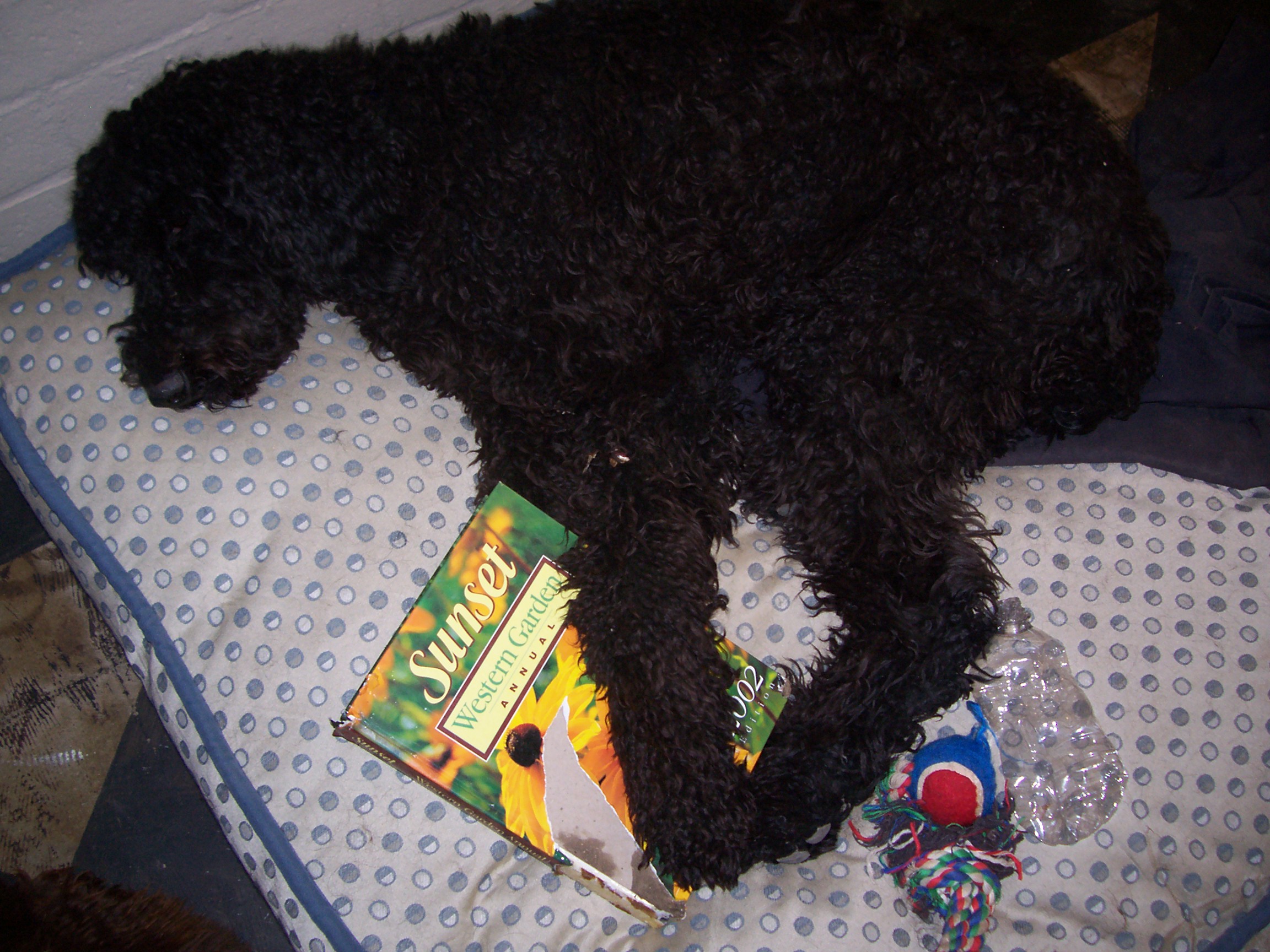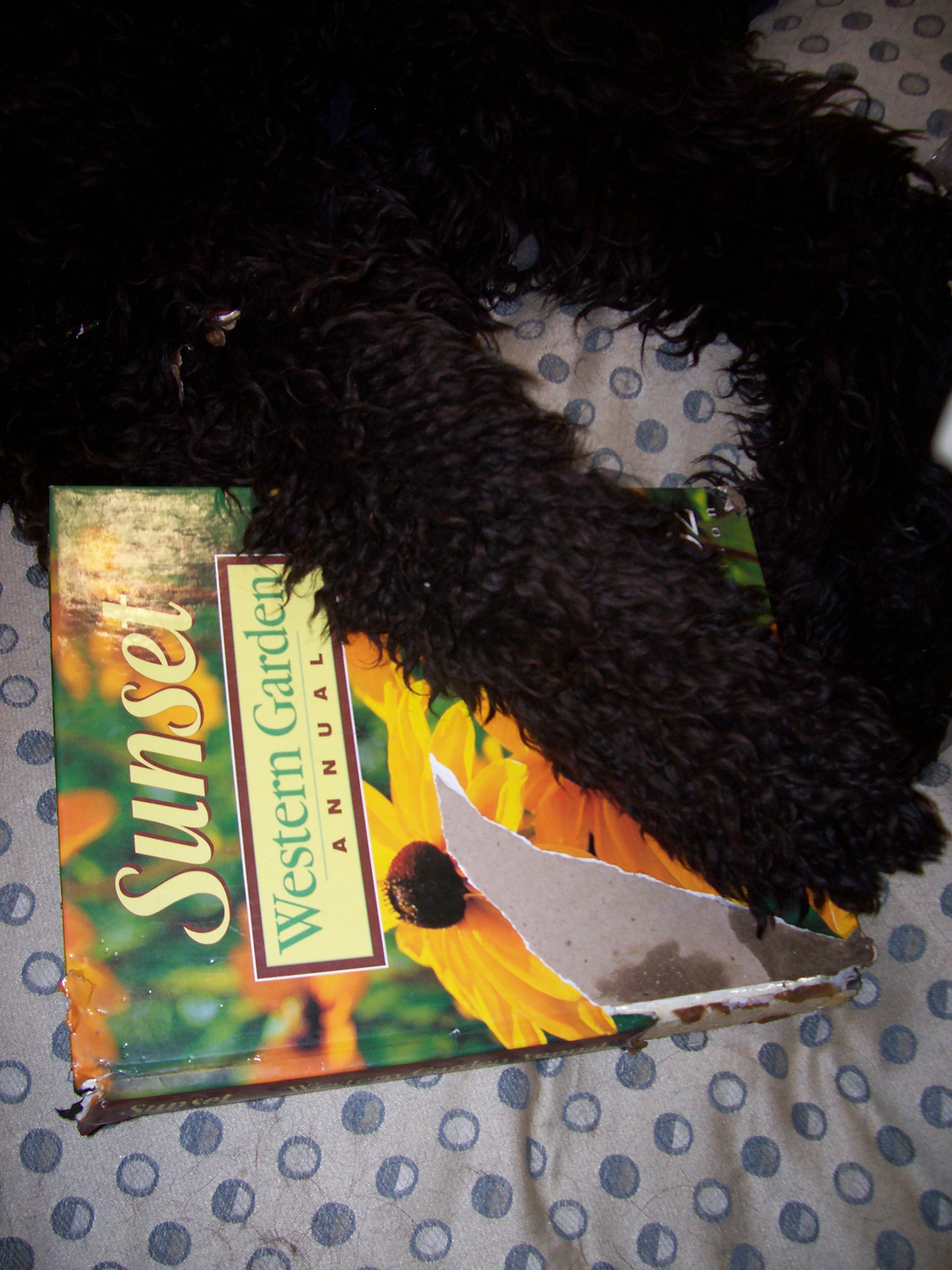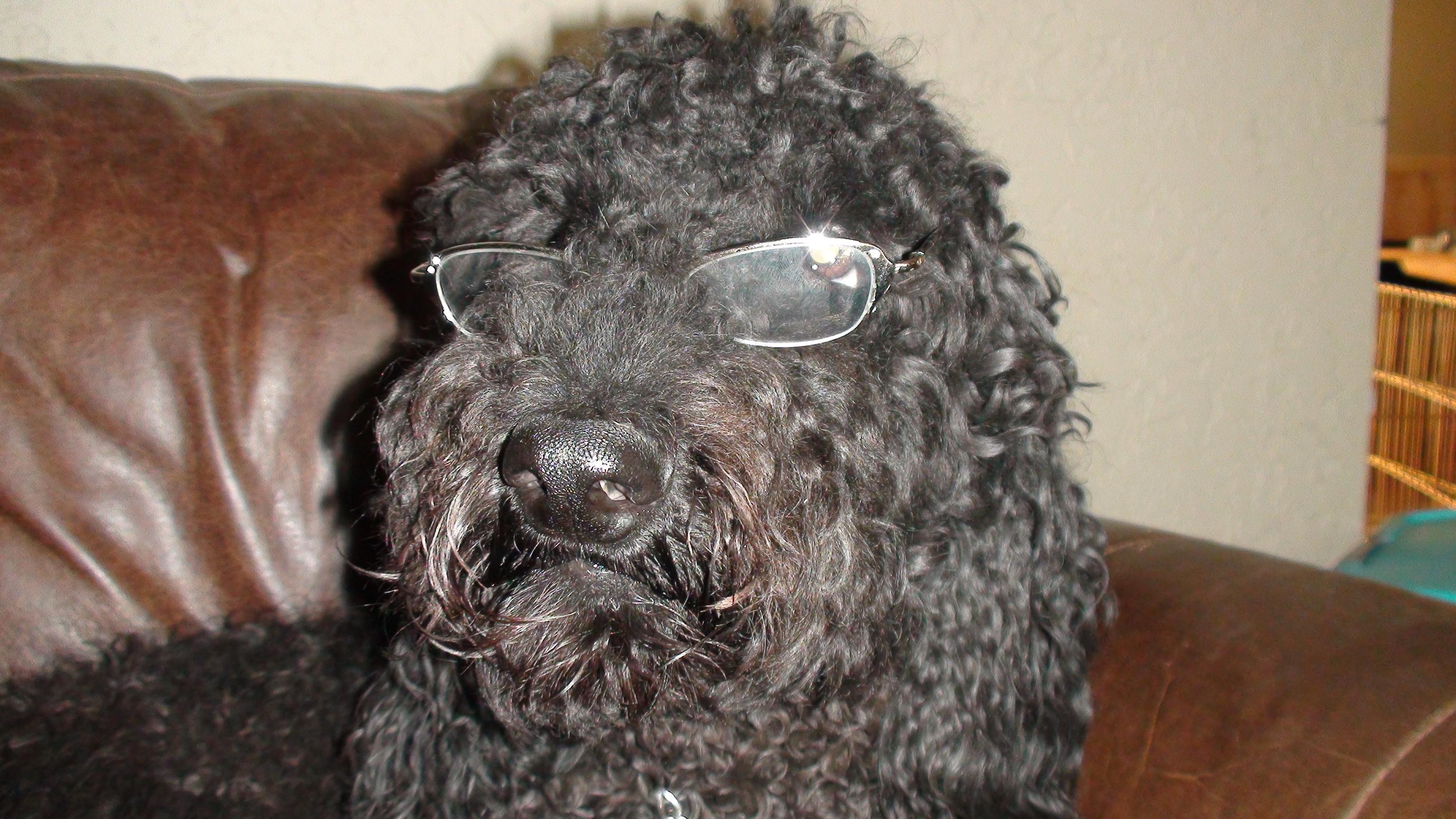Archives for Dog Training category
Posted on Oct 30, 2009
Barking, Behavioral Modification, Dog Psychology, Dog Training
Again, I say dogs bark. That’s what they will forever do. Some feel the need to express vocally more than others, and can be worked with to reduce their anxiousness through proper behavior modification.
Lassie was known for actually “saying” something with a bark; i.e., “Timmy is in the well.” “The barn is on fire.” His people knew when he barked, it meant something. Most of us wish that were the case with all dogs. The bark does mean something to the dog, but may be lost in translation. Like Lassie, dogs may bark as an alert to let you know someone is at the door or as a request to let you know they need to go outside.
While some dogs get this, others may need to be trained to let us know. I have found that while my dogs are not reserved when it comes to barking for warning, they are tongue-tied when their water bowl is empty. All random barking ceases as they sit quietly by the empty bowl waiting for me to look their way.
While we tend to think of barking as a dog’s form of communication, they may be relying on mental telepathy!
If you need assistance with an excessive, anxious barker, please contact me for guidance.
Posted on Oct 28, 2009
Dog Psychology, Dog Training, Palm Springs Dog Training, Socialization
I receive a lot of calls regarding dogs who are uncontrollable (their human’s words) on a leash when out in public. If the dog sees a bicycle or another dog, they pull and “go crazy!” One of my first questions is have they done basic obedience with their dog?
They sound a little skeptical, as they respond hesitantly, “We took him through the puppy class at PetSmart and he knows how to sit and lie down and that stuff.” I say, “Good, we can work with that.” Puppy classes are a great foundation for teaching your dog to listen and respond to you. It doesn’t matter if your dog was trained in the basics years ago, they will never forget it. It’s the human that forgets how to use these tools in every day life with their dog.
For starters, remind yourself and your dog of what you both know. And, that is they know how to respond to you when asked. You may need to work a little harder on the leash training and teaching your dog to walk in a relaxed state by your side. Once they do, when faced with a distraction of any kind, they are more likely to respond when asked to “sit and stay” or whatever is expected of them at the moment.
If you are having issues with your dog out in public and you have been through basic obedience, think of how to put that to use when outside on a leash. I’m sure you didn’t initially put the time into the training only to have a dog who doesn’t listen when it was really necessary.
If I can provide additional tips or you are need of specific guidance, please send a note in the box to the right.
Posted on Oct 22, 2009
Behavioral Modification, Dog Psychology, Dog Training, Retractable Leashes
Retractable leashes have their place. That place is not during training. While this leash seems to be very dog-friendly, it is not necessarily human-friendly, and does not provide the control most people need during training. When your dog responds to you while on a walk, it won’t matter what type of collar or leash you choose.
If you’re intention in having your dog on a leash is to learn to listen, respond, and respect you, then don’t use retractable leashes. I have heard from more than one person who has fractured their wrist by the handle when getting pulled by their dog (more about this below).
A favorite of mine is when someone approaches with two barking dogs who are pulling on the ever-lengthening thread toward my dogs (or dogs I am training) as they yell over the noise of their dogs’ vocal expression, “they’re friendly!” My advice is to respond with, “mine aren’t!” I use it all the time in order to keep them moving along down the road as I work with the dog who was the object of their attention to sit and stay as they pass.
You can also feel free to respond, “please keep walking, we’re in training.” Most people will respect it even if their dog has no clue what the word “training” means.
There is no way of knowing if once the dogs greet and the leashes get entwined their won’t be an altercation. It takes time to have a dog realize who is in charge and to listen to respond especially when an overly-anxious, uncontrolled dog is approaching.
This post isn’t so much about the negatives of retractable leashes as it is about the people using them without any sense of understanding the dog’s perspective and who is walking who. A dog doesn’t need to be heeling all the time. They should be given that freedom to sniff and be a dog; however, you (or they) may be asking for trouble if they are allowed to have full freedom on the leash and they still pull you down the street in an anxious state.
If you use a retractable leash and want to know more about my thinking on their correct usage, please send a note. I am glad to answer your questions!
Here’s an article on retractable leashes from Consumer Reports. Not intended as a scare tactic, but as information: Retractable Leashes Pose Problems
Posted on Oct 14, 2009
Dog Humor, Dog Psychology, Dog Training, Uncategorized
Perhaps you saw the segment on Animal Planet where a teacher taught his Labrador to read. The dog would read words printed on a flash card, and amazingly enough, would follow through with the instruction on the card! This is impressive.
I have seen a lot of amazing demonstrations of a dog’s intelligence, but the following tops them
all. . .my dog, Mac, can read books! In fact, he reads until he falls asleep. I think
I heard him say, “if only I had thumbs, turning pages would be so much easier.” Now I know what he was talking about.


Posted on Oct 09, 2009
Behavioral Modification, Dog Psychology, Dog Training, Doggie Rehab
Some people, trainers included, believe that dogs are just dogs. They can be treated harshly and will be fine. They can be left outside all of the time without being given attention, and be fine. I guess it depends on your definition of fine.
Dogs aren’t human (duh, I know!) They can, however, be treated in ways that destroy or, at a minimum, lessen their spirit or true nature. This can happen if they are treated too much like a human, and it can and does happen if they are sensitive in nature and treated with excessive force.
I have been working with a sweet Doberman who was sent away for training. She was trained alright. She returned to her human, with her head down, ears flat, and looking as sad as a dog can look. In just a few days, she is starting to act like a dog again. More than that, she’s acting like who she is. She hasn’t forgotten her commands (greatly needed as she is a service dog), but she is beginning to lift her head and receive praise rather than waiting for the force of a heavy-handed correction.
Dogs are like us! Some are more sensitive than others, so not all techniques work the same on every dog. It’s important to consider the breed when you are training. A Golden Retriever or Lab can sit or lie down in an instant. Great Danes, Dobermans, and Greyhounds are several of the breeds that sit and lie down in what may appear to be slow motion. Harsh corrections for not responding quick enough will only serve to make them cower and work against the relationship you are hoping to establish with them.
Be open to options and varying opinions when training your dog. There is more than one way to “train” a dog and it is certainly better to choose one that let’s your dog learn and still be the dog they are intended to be!
Posted on Oct 01, 2009
Behavioral Modification, Discussion Tab, Dog Psychology, Dog Training, Dogs and Instinct
As a constant observer of dogs, I am still amazed at how shifts in their behavior occur as they mature. It is interesting to see how at times they will appear to be practicing to be dominant. I’ll explain using two separate incidences.
I was working with a dog who is a big fan of chasing anything that moves or may move or used to move! On this occasion, we were making progress with him when I looked down to notice his hackles were up. I couldn’t help but think the timing was off. Something in him triggered this response and he even seemed unsure about his behavior. Natural, though it is, I believe he was in a sense trying out his maturing instincts. The dog didn’t appear to feel threatened. It was either a delayed or premature response. Practice perhaps?
Recently, my own dog who is 18 months of age, kicked up his back legs for the very first time. It was a macho move, but he was awkward and the action appeared misplaced. He looked up at me as if to say, “look, I’m kicking my legs up!” It was like he was practicing for when he would need to show his new-found dominant move. My other thought was that he had witnessed this strut as done by his little (tiny in comparison) brother, who exhibited this macho-manner after nearly every potty break.
I believe they are trying on things much like when you are fortunate enough to see a child as they catch their reflection in a mirror practicing a confident look or pose. It’s not a necessary posture at that moment, but it may be and one needs to be prepared!
As you enjoy the many changes that occur in the life of your dog, watch carefully for those times when they appear to be growing into their instincts.
If your maturing dog is exhibiting new behaviors and you aren’t sure how to handle them, please submit your question in the box to the right (I share it with Melody).
Posted on Sep 22, 2009
Behavioral Modification, Dog Chases Car, Dog Psychology, Dog Training, Palm Springs Dog Training
If your dog is one of those that loves to focus and obsess on moving objects, i.e., cars, golf carts, or even vapor trails from airplanes, this post is for you.
This activity may now be a pattern of behavior that is rapidly becoming a habit. See car – chase car. Sound familiar? You hear the engine in the distance (just after the dog) and brace yourself with the you-won’t-pull-me-down-this-time stance as you feel embarrassed and aggravated that your dog is officially a car chaser.
- First, you want to master (and be the master) of having your dog heel. This means your dog is walking on a loose leash next to your side.
- Work with them to sit when you stop and on command even when they are distracted. Add stay and increase their ability to stay by throwing treats in front of them, walking all the way around them, and using other staged distractions.
- Now, take your dog to the street and have someone in a car work with you to desensitize the dog to the moving vehicle. Have the car drive by slowly and stop in front of you allowing you time to have your dog sit. Repeat this process eventually working with your dog in a down and stay. This is a more submissive and relaxed position and they can’t lunge when lying down.
- The second you sense they are beginning to focus on the car or even just the sound of it approaching, say their name in a positive tone. You want them to shift their focus to you. You will be wasting your voice and energy if they have already bolted, you’ve lost control, and you are yelling their name followed by sit. Take a breath, get yourself focused and feeling confident, and continue the training.
If this behavior has been tolerated for awhile, it may take awhile to break their pattern of response. Some breeds are more prone to chase moving things, so you are also working against or with that instinct. Take it slow. Too much, too fast, and your dog may get over-stimulated.
It’s also important to consider that if your dog has been confined all day and has energy to burn, provide exercise prior to training so all of that energy isn’t going toward the behavior you want to correct – in this case, car chasing.
Please contact me in the box to the right if you have any questions! (I share this box with Melody)
Posted on Sep 15, 2009
Barking, Behavioral Modification, Dog Humor, Dog Training
I know you’ve heard it more than once from me that dogs bark. That’s their voice. How much they have to say and when they say it, may need to be fine-tuned!
As a personal note, my little guy, Moby (please never tell him he is little), feels the need to exit the slider as he announces to any and all who might go before, after, or are outside when he approaches that he is coming and he is to be feared.
As the temperatures cool and dogs (in the desert) are out more, they may become more excited (accompanied by vocal expression – i.e., barking) in exclamation that they can once again be given free access to the outside world that fears and respects them.
Tonight, Moby was declaring his presence to a neighboring dog. I walked outside and sometimes that alone is enough. This time, I gave the human hand signal for “cut” by turning my flattened hand toward my neck as I said “ixnay arkingbay.” He stopped immediately and hasn’t barked since.
Why do I share this moment of enlightment? To let you know that once your dog listens, respects, and responds to you, you can even speak in pig Latin and they will get it. It all means stop, and most important is the energy behind your words. Their respect for you will be evident.
Posted on Sep 03, 2009
Behavioral Modification, Dog Psychology, Dog Training
Gaining the respect of someone is much the same as it is with a dog. It’s not about how strong or big or how loud you can yell. It’s about being in a calm state of mind that is confident, in control, and worthy of the respect you expect.
Melody, a 5 lb yorkie, came into the house and gained the respect of the other dogs. Let’s face it, she’s a toothless, de-barked little thing who manages to handle the big dogs just fine. She is afraid of a human’s intention, but a 120-lb Dane will easily move away from it’s bowl of food if Melody approaches. They all clear a path for her as she dodges big feet and long legs to get to her bed.
If she had words, she would be a good example for a woman’s self-defense course on how to assert yourself with little effort. She is who she is and they know she knows it! I wonder what she does know? It’s definitely the calm, assertive nature Cesar Millan speaks of so often.
Humans usually require training tools in working their dogs, and there’s nothing wrong with that. That’s what they are – tools. Be it a collar and a leash or a remote training device, it will be far more effective when we are worthy of the dog’s respect without these tools. When the collar comes off, the dog should still listen and respond and basically look to you for approval because they know who is in charge.
Their tail won’t be tucked in fear, their ears won’t be back and heads down because they are afraid of the hand approaching them. They will be happy, confident, and balanced dogs whose respect of you is natural.
Posted on Aug 31, 2009
Behavioral Modification, Dog Psychology, Dog Training
Come is one of the most difficult commands to teach a dog. Better said, it is one of the most difficult commands for your dog to respond to consistently. It may take several years to master it. It’s tough because in typical situations, you are calling your dog away from a distraction, which to them may be far more interesting than you.
I encourage you to continue working with your dog on this very important command. A friend of mine told me she was out with her two Scottie’s when someone commented on how well behaved they were and how they came to her when called. She smiled as she replied, “thanks, it only took 10 years!” Aren’t all relationships a work in progress?
I have had concerns that my dogs’ vision may be the problem. Perhaps they couldn’t see me clearly and were not responding as quickly as I would like. So, I gave them an eye exam, and this was the result.



Here’s a video with training tips on teaching your dog to come.













